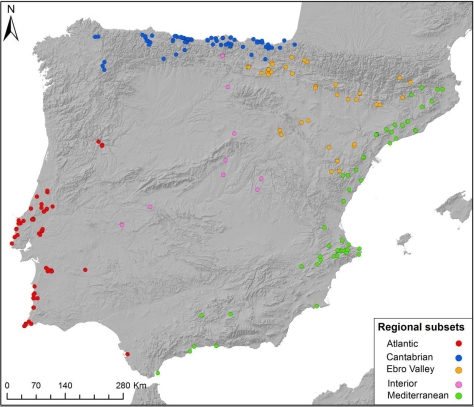NewsNext Previous
The population history of the last hunter-gatherers of the Iberian Peninsula
Between 18.000 to 8.000 years ago, when significant climatic changes which impacted population dynamics
Human populations have an inherent capacity for rapid growth checked by the constraints of the environment, during episodes of climate change
This study in published today in Nature Communications
The scientific journal Nature communications is publishing a new study today about the demographic dynamics of the last populations of hunter-gatherers that inhabited the Iberian Peninsula between 18.000 to 8.000 years ago. This period, known as the Pleistocene-Holocene Transition, is characterised by extreme changes in climatic and environmental conditions whose impact on prehistoric societies has been debated for decades.

The paper analyses the whole radiocarbon record of the Iberian Peninsula for this period, conducting thousands of computational simulations to compare the goodness of fit of different demographic models. Therefore, three different demographic phases have been identified for this period. First, during the end of the last glacial cycle, between 16.600 and 12.700 years ago, the population grew exponentially. In contrast, between 12.700 and 10.200 years ago, during the cold episode of the Younger Dryas and the rapid warming of Early Holocene onset, authors find a sustained phase of population contraction and stabilisation. Finally, at third demographic phase is identified between 10.200 and 8.000 years ago, during the Mesolithic period, with a rapid population increase followed by stabilisation under a new demographic threshold.
The results show that prehistoric foragers had an inherent capacity for rapid demographic growth, but this was checked by the constraints of the environment, especially during periods of climate change.
This research has been lead by a research team of IPHES (Institut Català de Paleoecologia Humana i Evolució Social) and Universitat Rovira i VIrgili (URV) in the context of the ERC project PALEODEM (Late Glacial and Postglacial Population History and Cultural Transmission in Iberia), supported by the European Research Council. Researchers from the Department of Archaeology, Anthropology & Forensic Science of the Bournemouth University and the School of Business at the Warwick University have also taken part in the investigation.
Bibliographic reference
Fernández-López de Pablo, J., Gutiérrez-Roig, M., Gómez-Puche, M., McLaughlin, R., Silva, F., Lozano, S. “Palaeodemographic modelling supports a population bottleneck during the Pleistocene-Holocene transition in Iberia”, Nature Communications (2019) DOI: 10.1038/s41467-019-09833-3,


